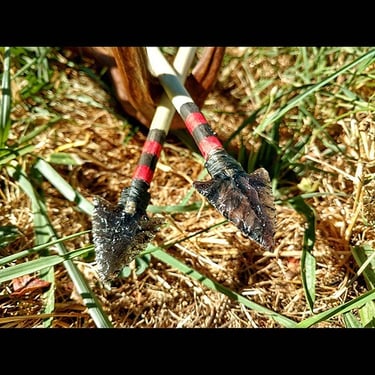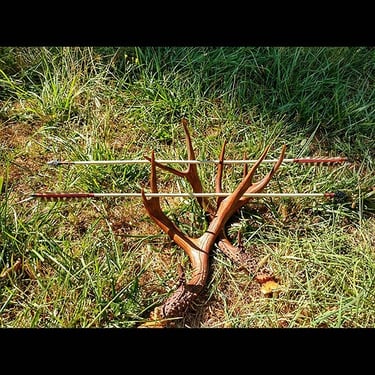Bow & Arrows
Making a Bow
First is the wood for the Bow. The bow is a stick with a string tied between both ends, which propel the arrow to its target. Each section of the bow from the tip to the handle must bend equally and gradually over its length. The wood must be flexible with the ability to snap back into position quickly. If you are able to join one of our classes we will help you with deciding which wood is best and how to tell. However if you find yourself in surroundings where you don't know which kind of tree to use, you can do a simple test to determine whether the wood is suitable for a bow.
A quick survival bow can be made with a small branch about the size of your thumb and about four feet long. Cut two knocks on either side. These notches will keep the string from sliding of the tips. They are cut in at a 45-degree angle, pointing toward the handle and deep enough to accept the bow string. String it up with a little tension and bend gently, the side of the bow bending less should have the back side closest to the string scraped a little at a time until both sides bend evenly. For survival purposes it doesn't have to perfect.
Creating Cord
If you are without any type of synthetic cordage, a cord can be made from natural materials such as milkweed, yucca or nettle. Natives used sinew and gut to create durable bowstrings. When the bow is strung, the cord should stand off the bow by about 5 inches. This is the brace height, and also helps with the snap of the bow.
Making Your Arrows
Arrows can be made out of many materials. Straight shoots from ocean spray, willow or red twig dogwood all work well. They should be as straight as possible, clear of branches and knots, and taper gradually end-to-end. The small end, which will be notched for the string, should be large enough for this knock without compromising the strength of the wood to either side. The bark is scraped from the shoot with a knife or stone, and then the shaft is held over a fire to straighten.
To straighten, heat up a crooked spot, and then bend it backwards, slightly past straight. Upon cooling, this spot will set up where it's been bent to. Look down the length of the arrow periodically to check on its straightness. The large end of the arrow can simply be sharpened to a point, or notched to accept a point of bone, stone, or steel.
Fletchings can range from a bundle of pine needles lashed to the end of the arrow nearest the string, the best is a couple of feathers with their quill tips tied to the shaft. Sinew wrapping is the preferred method as it contains its own glue and also shrinks as it dries holding the fletchings tightly and providing a smooth transition.
Pitch glue is made from conifer pitch mixed 1 part pitch with 1 part finely ground charcoal and 1 part finely ground herbivore poo. The three parts are mixed over a low fire until fully combined, then taken away from the heat. As the mixture cools spin it onto the end of a small stick. To use simply heat it back up over a flame and use like hot glue.
Knapping Arrowheads
Broken bottles are everywhere, and they make beautiful points. Its possible to make an arrowhead with nothing more than a piece of glass and a small rounded rock, an antler tine can also be used to flake the glass into shape.




The bow and arrow are effective hunting tools. It allows you to increase the distance between you and your prey.
The Language...
Back: The side of a bow that faces forward, or away from the archer.
Belly: The inside of a bow . . . the side facing the archer.
Brace: To string a bow.
Braced height: The distance between the string and handle of a braced, or strung, bow.
Bowyer: The bow maker.
Draw: The distance, measured in inches, that an archer pulls the bowstring. As a verb, the act of pulling a bow back.
Ears: The forward-curving tips of a re-curved bow
